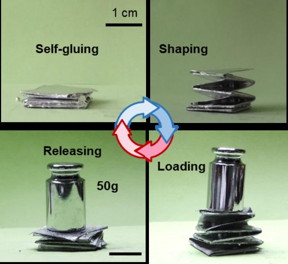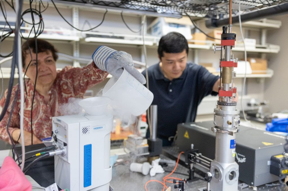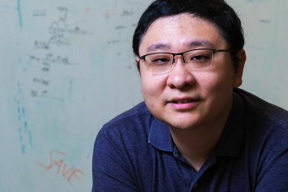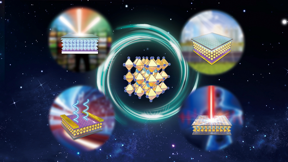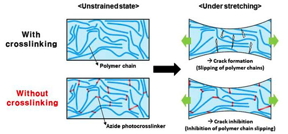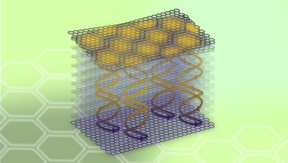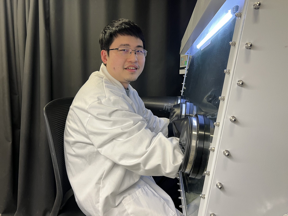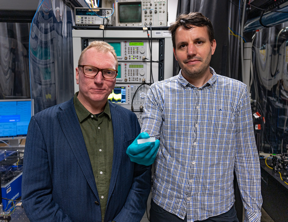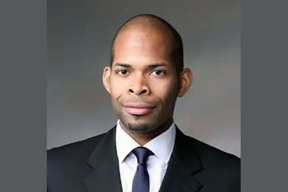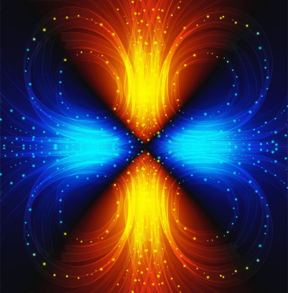Главная > Нажмите > Researchers at Purdue discover superconductive images are actually 3D and disorder-driven fractals
 |
Абстрактные:
Meeting the world’s energy demands is reaching a critical point. Powering the technological age has caused issues globally. It is increasingly important to create superconductors that can operate at ambient pressure and temperature. This would go a long way toward solving the energy crisis.
Исследователи из Purdue обнаружили, что сверхпроводящие изображения на самом деле являются трехмерными фракталами, управляемыми беспорядком.
West Lafayette, IN | Posted on May 12th, 2023Advancements with superconductivity hinge on advances in quantum materials. When electrons inside of quantum materials undergo a phase transition, the electrons can form intricate patterns, such as fractals. A fractal is a never-ending pattern. When zooming in on a fractal, the image looks the same. Commonly seen fractals can be a tree or frost on a windowpane in winter. Fractals can form in two dimensions, like the frost on a window, or in three-dimensional space like the limbs of a tree.
Dr. Erica Carlson, a 150th Anniversary Professor of Physics and Astronomy at Purdue University, led a team that developed theoretical techniques for characterizing the fractal shapes that these electrons make, in order to uncover the underlying physics driving the patterns.
Carlson, a theoretical physicist, has evaluated high resolution images of the locations of electrons in the superconductor Bi2-xPbzSr2-yLayCuO6+x (BSCO), and determined that these images are indeed fractal and discovered that they extend into the full three-dimensional space occupied by the material, like a tree filling space.
What was once thought of as random dispersions within the fractal images are purposeful and, shockingly, not due to an underlying quantum phase transition as expected, but due to a disorder-driven phase transition.
Carlson led a collaborative team of researchers across multiple institutions and published their findings, titled "Critical nematic correlations throughout the superconducting doping range in Bi2-xPbzSr2-yLayCuO6+x," in Nature Communications.
The team includes Purdue scientists and partner institutions. From Purdue, the team includes Carlson, Dr. Forrest Simmons, recent PhD student, and former PhD students Dr. Shuo Liu and Dr. Benjamin Phillabaum. The Purdue team completed their work within the Purdue Quantum Science and Engineering Institute (PQSEI). The team from partner institutions includes Dr. Jennifer Hoffman, Dr. Can-Li Song, Dr. Elizabeth Main of Harvard University, Dr. Karin Dahmen of the University of Urbana-Champaign, and Dr. Eric Hudson of Pennsylvania State University.
“The observation of fractal patterns of orientational (‘nematic’) domains – cleverly extracted by Carlson and collaborators from STM images of the surfaces of crystals of a cuprate high temperature superconductor – is interesting and aesthetically appealing on its own, but also of considerable fundamental importance in coming to grips with the essential physics of these materials,” says Dr. Steven Kivelson, the Prabhu Goel Family Professor at Stanford University and a theoretical physicist specializing in novel electronic states in quantum materials. “Some form of nematic order, typically thought to be an avatar of a more primitive charge-density-wave order, has been conjectured to play an important role in the theory of the cuprates, but the evidence in favor of this proposition has previously been ambiguous at best. Two important inferences follow from Carlson et al.’s analysis: 1) The fact that the nematic domains appear fractal implies that the correlation length – the distance over which the nematic order maintains coherence – is larger than the field of view of the experiment, which means that it is very large compared to other microscopic scales. 2) The fact that patterns that characterize the order are the same as those obtained from studies of the three dimensional random-field Ising model – one of the paradigrmatic models of classical statistical mechanics – suggests that the extent of the nematic order is determined by extrinsic quantities and that intrinsically (i.e. in the absence of crystalline imperfections) it would exhibit still longer range correlations not just along the surface, but extending deep into the bulk of the crystal.”
High resolution images of these fractals are painstakingly taken in Hoffman’s lab at Harvard University and Hudson’s lab, now at Penn State, using scanning tunneling microscopes (STM) to measure electrons at the surface of the BSCO, a cuprate superconductor. The microscope scans atom by atom across the top surface of the BSCO, and what they found was stripe orientations that went in two different directions instead of the same direction. The result, seen above in red and blue, is a jagged image that forms interesting patterns of electronic stripe orientations.
“The electronic patterns are complex, with holes inside of holes, and edges that resemble ornate filigree,” explains Carlson. “Using techniques from fractal mathematics, we characterize these shapes using fractal numbers. In addition, we use statistics methods from phase transitions to characterize things like how many clusters are of a certain size, and how likely the sites are to be in the same cluster.”
Once the Carlson group analyzed these patterns, they found a surprising result. These patterns do not form only on the surface like flat layer fractal behavior, but they fill space in three dimensions. Simulations for this discovery were carried out at Purdue University using Purdue’s supercomputers at Rosen Center for Advanced Computing. Samples at five different doping levels were measured by Harvard and Penn State, and the result was similar among all five samples.
The unique collaboration between Illinois (Dahmen) and Purdue (Carlson) brought cluster techniques from disordered statistical mechanics into the field of quantum materials like superconductors. Carlson’s group adapted the technique to apply to quantum materials, extending the theory of second order phase transitions to electronic fractals in quantum materials.
“This brings us one step closer to understanding how cuprate superconductors work,” explains Carlson. “Members of this family of superconductors are currently the highest temperature superconductors that happen at ambient pressure. If we could get superconductors that work at ambient pressure and temperature, we could go a long way toward solving the energy crisis because the wires we currently use to run electronics are metals rather than superconductors. Unlike metals, superconductors carry current perfectly with no loss of energy. On the other hand, all the wires we use in outdoor power lines use metals, which lose energy the whole time they are carrying current. Superconductors are also of interest because they can be used to generate very high magnetic fields, and for magnetic levitation. They are currently used (with massive cooling devices!) in MRIs in hospitals and levitating trains.”
Next steps for the Carlson group are to apply the Carlson-Dahmen cluster techniques to other quantum materials.
“Using these cluster techniques, we have also identified electronic fractals in other quantum materials, including vanadium dioxide (VO2) and neodymium nickelates (NdNiO3). We suspect that this behavior might actually be quite ubiquitous in quantum materials,” says Carlson.
This type of discovery leads quantum scientists closer to solving the riddles of superconductivity.
“The general field of quantum materials aims to bring to the forefront the quantum properties of materials, to a place where we can control them and use them for technology,” Carlson explains. “Each time a new type of quantum material is discovered or created, we gain new capabilities, as dramatic as painters discovering a new color to paint with."
Funding for the work at Purdue University for this research includes the National Science Foundation, the Bilsland Dissertation Fellowship (for Dr. Liu), and Research Corporation for Science Advancement.
####
О Университете Пердью
Университет Пердью — ведущее государственное исследовательское учреждение, разрабатывающее практические решения самых сложных задач современности. Каждый из последних пяти лет Purdue входит в число 10 самых инновационных университетов США по версии US News & World Report и проводит исследования, которые меняют мир, и невероятные открытия. Стремясь к практическому и онлайн-обучению в реальном мире, Purdue предлагает преобразующее образование для всех. Стремясь обеспечить доступность и доступность, Purdue заморозила обучение и большинство сборов на уровне 2012–13 годов, что позволило большему количеству студентов, чем когда-либо, получить высшее образование без долгов. Посмотрите, как Purdue никогда не останавливается в настойчивом стремлении к следующему гигантскому скачку в https://stories.purdue.edu .
About the Department of Physics and Astronomy at Purdue University
Purdue Department of Physics and Astronomy has a rich and long history dating back to 1904. Our faculty and students are exploring nature at all length scales, from the subatomic to the macroscopic and everything in between. With an excellent and diverse community of faculty, postdocs, and students who are pushing new scientific frontiers, we offer a dynamic learning environment, an inclusive research community, and an engaging network of scholars.
Physics and Astronomy is one of the seven departments within the Purdue University College of Science. World-class research is performed in astrophysics, atomic and molecular optics, accelerator mass spectrometry, biophysics, condensed matter physics, quantum information science, particle and nuclear physics. Our state-of-the-art facilities are in the Physics Building, but our researchers also engage in interdisciplinary work at Discovery Park District at Purdue, particularly the Birck Nanotechnology Center and the Bindley Bioscience Center. We also participate in global research including at the Large Hadron Collider at CERN, Argonne National Laboratory, Brookhaven National Laboratory, Fermilab, the Stanford Linear Accelerator, the James Webb Space Telescope, and several observatories around the world.
About the Purdue Quantum Science and Engineering Institute (PQSEI)
Located in Discovery Park District, PQSEI fosters the development of practical and impactful aspects of quantum science and focuses on discovering and studying new materials, devices, and basic physical quantum systems that will be suited for integration into tomorrow’s technology. It encourages interdisciplinary collaboration leading to the design and realization of quantum devices with enhanced functionality and performance close to the fundamental limit, aiming to ultimately bring them to a vast community of users. PQSEI faculty work on a broad range of topics in quantum science and engineering including quantum materials and devices, quantum photonics, atomic molecular and optical physics, quantum chemistry, quantum measurement and control, quantum simulation, and quantum information and computing. Finally, PQSEI works to train the next generation of quantum scientists and engineers in order to meet the growing quantum workforce demands.
Для получения дополнительной информации, пожалуйста, нажмите здесь
Контактная информация:
Бриттани Стефф
университет Пердью
Офис: 765-494-7833
Copyright © Purdue University
Если у вас есть комментарий, пожалуйста Контакты нас.Издатели новостных выпусков, а не 7th Wave, Inc. или Nanotechnology Now, несут единоличную ответственность за точность содержания.
| Ссылки по теме |
| Связанные новости Пресса |
Новости и информация
![]() Лазерная прямая запись гибких датчиков влажности на основе Ga2O3/жидкого металла 12-е мая, 2023
Лазерная прямая запись гибких датчиков влажности на основе Ga2O3/жидкого металла 12-е мая, 2023
![]() Прорыв в оптических свойствах MXenes: двумерные гетероструктуры открывают новые идеи 12-е мая, 2023
Прорыв в оптических свойствах MXenes: двумерные гетероструктуры открывают новые идеи 12-е мая, 2023
![]() Перовскитный электрохимический элемент новой конструкции для излучения и обнаружения света 12-е мая, 2023
Перовскитный электрохимический элемент новой конструкции для излучения и обнаружения света 12-е мая, 2023
Сверхпроводимость
Govt.-Законодательство / Положение / Финансирование / Политика
![]() Оптическая коммутация с рекордными скоростями открывает двери для сверхбыстрой электроники и компьютеров на основе света: Март 24th, 2023
Оптическая коммутация с рекордными скоростями открывает двери для сверхбыстрой электроники и компьютеров на основе света: Март 24th, 2023
![]() Робот-гусеница демонстрирует новый подход к передвижению мягкой робототехники Март 24th, 2023
Робот-гусеница демонстрирует новый подход к передвижению мягкой робототехники Март 24th, 2023
![]() Полупроводниковая решетка объединяет электроны и магнитные моменты Март 24th, 2023
Полупроводниковая решетка объединяет электроны и магнитные моменты Март 24th, 2023
Возможные Фьючерсы
![]() Лазерная прямая запись гибких датчиков влажности на основе Ga2O3/жидкого металла 12-е мая, 2023
Лазерная прямая запись гибких датчиков влажности на основе Ga2O3/жидкого металла 12-е мая, 2023
![]() Прорыв в оптических свойствах MXenes: двумерные гетероструктуры открывают новые идеи 12-е мая, 2023
Прорыв в оптических свойствах MXenes: двумерные гетероструктуры открывают новые идеи 12-е мая, 2023
![]() Перовскитный электрохимический элемент новой конструкции для излучения и обнаружения света 12-е мая, 2023
Перовскитный электрохимический элемент новой конструкции для излучения и обнаружения света 12-е мая, 2023
Находки
![]() Лазерная прямая запись гибких датчиков влажности на основе Ga2O3/жидкого металла 12-е мая, 2023
Лазерная прямая запись гибких датчиков влажности на основе Ga2O3/жидкого металла 12-е мая, 2023
![]() Прорыв в оптических свойствах MXenes: двумерные гетероструктуры открывают новые идеи 12-е мая, 2023
Прорыв в оптических свойствах MXenes: двумерные гетероструктуры открывают новые идеи 12-е мая, 2023
Объявления
![]() Лазерная прямая запись гибких датчиков влажности на основе Ga2O3/жидкого металла 12-е мая, 2023
Лазерная прямая запись гибких датчиков влажности на основе Ga2O3/жидкого металла 12-е мая, 2023
![]() Прорыв в оптических свойствах MXenes: двумерные гетероструктуры открывают новые идеи 12-е мая, 2023
Прорыв в оптических свойствах MXenes: двумерные гетероструктуры открывают новые идеи 12-е мая, 2023
![]() Перовскитный электрохимический элемент новой конструкции для излучения и обнаружения света 12-е мая, 2023
Перовскитный электрохимический элемент новой конструкции для излучения и обнаружения света 12-е мая, 2023
Интервью / Рецензии на книги / Рефераты / Репортажи / Подкасты / Журналы / Официальные документы / Плакаты
![]() Лазерная прямая запись гибких датчиков влажности на основе Ga2O3/жидкого металла 12-е мая, 2023
Лазерная прямая запись гибких датчиков влажности на основе Ga2O3/жидкого металла 12-е мая, 2023
![]() Прорыв в оптических свойствах MXenes: двумерные гетероструктуры открывают новые идеи 12-е мая, 2023
Прорыв в оптических свойствах MXenes: двумерные гетероструктуры открывают новые идеи 12-е мая, 2023
![]() Перовскитный электрохимический элемент новой конструкции для излучения и обнаружения света 12-е мая, 2023
Перовскитный электрохимический элемент новой конструкции для излучения и обнаружения света 12-е мая, 2023
Энергия
![]() Направление механической энергии в предпочтительном направлении 14-е апреля, 2023
Направление механической энергии в предпочтительном направлении 14-е апреля, 2023
![]() Универсальная стратегия превращения порошка в порошок с добавкой HCl для получения бессвинцовых перовскитов. Март 24th, 2023
Универсальная стратегия превращения порошка в порошок с добавкой HCl для получения бессвинцовых перовскитов. Март 24th, 2023
![]() Сделайте их достаточно тонкими, и антисегнетоэлектрические материалы станут сегнетоэлектрическими. 10-е февраля, 2023
Сделайте их достаточно тонкими, и антисегнетоэлектрические материалы станут сегнетоэлектрическими. 10-е февраля, 2023
- SEO-контент и PR-распределение. Получите усиление сегодня.
- ПлатонАйСтрим. Анализ данных Web3. Расширение знаний. Доступ здесь.
- Чеканка будущего с Эдриенн Эшли. Доступ здесь.
- Покупайте и продавайте акции компаний PREIPO® с помощью PREIPO®. Доступ здесь.
- Источник: http://www.nanotech-now.com/news.cgi?story_id=57345
- :имеет
- :является
- :нет
- :куда
- 1
- 10
- 10
- 28
- 2D
- 2D материалы
- 3d
- 3
- a
- выше
- ускоритель
- доступ
- доступность
- точность
- через
- на самом деле
- адаптированный
- дополнение
- продвинутый
- продвижение
- авансы
- возраст
- Стремясь
- Цель
- AL
- Все
- вдоль
- Также
- окружающий
- среди
- an
- анализ
- и
- Юбилей
- объявляет
- привлекательный
- появиться
- Применить
- подхода
- апрель
- МЫ
- Национальная лаборатория Аргон
- около
- AS
- аспекты
- астрономия
- астрофизика
- At
- атом
- Атомные и молекулярные
- аватар
- назад
- основной
- BE
- , так как:
- становиться
- было
- Вениамин
- ЛУЧШЕЕ
- между
- Биофизика
- Синии
- Разрыв
- приносить
- Приносит
- широкий
- принес
- Университет Брауна
- Строительство
- но
- by
- CAN
- кандидат
- возможности
- углерод
- Карлсон
- нести
- проведение
- вызванный
- Центр
- CERN
- определенный
- CGI
- проблемы
- охарактеризовать
- химия
- нажмите на
- Закрыть
- ближе
- Кластер
- сотрудничество
- совместный
- Колледж
- цвет
- COM
- приход
- комментарий
- привержен
- обычно
- Связь
- сообщество
- сравненный
- Заполненная
- комплекс
- компьютеры
- вычисление
- Сгущенное вещество
- проведение
- значительный
- содержание
- контроль
- Конверсия
- КОРПОРАЦИЯ
- Корреляция
- может
- Создайте
- создали
- кризис
- критической
- Crystal
- Текущий
- В настоящее время
- Знакомства
- дебаты
- глубоко
- обеспечивает
- запросы
- демонстрирует
- Кафедра
- ведомства
- Проект
- определены
- развивать
- развитый
- развивающийся
- Развитие
- Устройства
- различный
- размеры
- направлять
- направление
- инструкция
- обнаружить
- открытый
- обнаружение
- открытие
- расстояние
- район
- Разное
- do
- доменов
- Двери
- драматично
- вождение
- два
- динамический
- e
- Е & Т
- каждый
- Обучение
- Электронный
- Electronics
- электронов
- позволяет
- призывает
- конец
- энергетика
- энергетический кризис
- заниматься
- привлечение
- Проект и
- Инженеры
- расширение
- достаточно
- Окружающая среда
- вереск
- существенный
- Эфир (ETH)
- оценивается
- НИКОГДА
- многое
- , поскольку большинство сенаторов
- отлично
- проявлять
- ожидаемый
- эксперимент
- Объясняет
- Исследование
- продлить
- простирающийся
- изготовление
- средства
- факт
- семья
- в пользу
- подвиг
- февраль
- Сборы
- поле
- Поля
- заполнять
- пленки
- в заключение
- результаты
- First
- Впервые
- плоский
- гибкого
- фокусируется
- следовать
- Что касается
- Передний край
- форма
- Бывший
- формы
- найденный
- Год основания
- от
- Границы
- Мороз
- замороженные
- полный
- функциональность
- фундаментальный
- будущее
- Gain
- Общие
- порождать
- поколение
- получить
- гигант
- GIF
- Глобальный
- ГЛОБАЛЬНО
- Go
- Гоел
- Золото
- выпускник
- Графен
- группы
- Рост
- рука
- практический
- происходить
- Гарвардский
- Гарвардский университет
- Есть
- High
- наивысший
- очень
- Петля
- история
- Отверстия
- больницы
- Как
- HTML
- HTTP
- HTTPS
- Гибридный
- i
- идентифицированный
- if
- Иллинойс
- изображение
- изображений
- эффектных
- значение
- важную
- in
- В других
- Инк
- включает в себя
- В том числе
- включительно
- все больше и больше
- недорогой
- информация
- инновационный
- вместо
- Институт
- учреждение
- учреждения
- интеграции.
- интерес
- интересный
- Мультиязычность
- в
- в действительности
- вопросы
- IT
- ЕГО
- космического телескопа Джеймса Вебба
- январь
- Япония
- Дженнифер
- журнал
- всего
- лаборатория
- лаборатория
- большой
- больше
- Фамилия
- запуск
- слой
- ведущий
- Лиды
- Leap
- изучение
- привело
- Длина
- уровни
- такое как
- Вероятно
- ОГРАНИЧЕНИЯ
- линий
- связи
- места
- Длинное
- давнишний
- дольше
- ВЗГЛЯДЫ
- терять
- от
- Главная
- поддерживает
- сделать
- многих
- Март
- Масса
- массивный
- материала
- материалы
- математика
- Вопрос
- Май..
- означает
- проводить измерение
- измерение
- механический
- механика
- Встречайте
- объединение
- металл
- Драгоценные металлы
- метод
- методы
- Микроскоп
- может быть
- модель
- Модели
- молекулярный
- молекула
- БОЛЕЕ
- самых
- с разными
- нанотехнологии
- национальный
- Национальная наука
- природа
- сеть
- сеть
- Нейтральные
- никогда
- Новые
- Новости
- следующий
- нет
- роман
- сейчас
- ядерный
- Ядерная физика
- номера
- полученный
- октябрь
- of
- предлагают
- Предложения
- on
- консолидировать
- ONE
- онлайн
- только
- открытый
- Откроется
- работать
- Оптическая физика
- оптика
- or
- заказ
- органический
- Origin
- Другие контрактные услуги
- наши
- внешний
- На открытом воздухе
- за
- собственный
- красить
- Парк
- участвовать
- частица
- Частица и ядерный
- особенно
- партнер
- шаблон
- паттеранами
- вымостить
- Пенн
- Пенсильвания
- производительность
- фаза
- PHP
- физический
- Физика
- Часть
- плазма
- пластик
- Платон
- Платон Интеллектуальные данные
- ПлатонДанные
- Играть
- пожалуйста
- Точка
- После
- размещены
- потенциал
- мощностью
- Включение питания
- практическое
- привилегированный
- Подготовить
- подготовка
- нажмите
- Пресс-релизы
- давление
- предварительно
- примитивный
- зонд
- Профессор
- свойства
- предлагает
- предложило
- предложение.
- обеспечивать
- что такое варган?
- опубликованный
- Издательство
- Нажимать
- Квантовый
- квантовые компьютеры
- квантовая информация
- квантовые материалы
- квантовое измерение
- квантовые системы
- случайный
- ассортимент
- вошел
- быстро
- скорее
- достигнув результата
- реальный мир
- реализация
- последний
- запись
- Red
- Reddit.
- освободить
- публикации
- отчету
- исследованиям
- Научно-исследовательское сообщество
- исследователи
- Постановления
- ответственный
- результат
- Итоги
- возвращают
- Богатые
- Роли
- Run
- s
- то же
- Сохранить
- говорит
- Весы
- сканирование
- Ученые
- Наука
- Ученые
- Поиск
- Во-вторых
- Сектора юридического права
- посмотреть
- видел
- датчик
- оседает
- семь
- несколько
- формы
- Поделиться
- Шоу
- аналогичный
- просто
- моделирование
- Сайтов
- Размер
- мягкая
- Решения
- Решение
- песня
- Space
- космический телескоп
- Искриться
- специализация
- скорость
- Вращение
- стабильный
- Стэнфорд
- Стэнфордский университет
- Начало
- Область
- современное состояние
- Области
- статистический
- статистика
- Шаг
- Шаги
- По-прежнему
- Останавливает
- диск
- Стратегия
- полоса
- Структура
- "Студент"
- Студенты
- исследования
- Кабинет
- изучение
- отправить
- такие
- Предлагает
- подходящее
- суперкомпьютерах
- Сверхпроводимость
- поддержка
- Поверхность
- удивительный
- системы
- команда
- снижения вреда
- технологический
- Технологии
- телескоп
- чем
- который
- Ассоциация
- мир
- их
- Их
- теоретический
- теория
- Эти
- они
- вещи
- этой
- те
- мысль
- три
- трехмерный
- по всему
- время
- титулованный
- в
- Сегодняшних
- топ
- Темы
- к
- Train
- поезда
- преобразующей
- переход
- переходы
- дерево
- два
- напишите
- типично
- нам
- вездесущий
- В конечном счете
- нетрадиционный
- открывай
- лежащий в основе
- понимание
- созданного
- Объединенный
- США
- Universal
- Университеты
- Университет
- В отличие от
- беспрецедентный
- us
- использование
- используемый
- пользователей
- через
- Огромная
- очень
- Вид
- законопроект
- Wave
- Путь..
- we
- пошел
- были
- запад
- Что
- когда
- который
- КТО
- все
- будете
- Зима
- в
- Работа
- Трудовые ресурсы
- работает
- Мир
- изменяющий мир
- мировой класс
- мире
- бы
- письмо
- Yahoo
- лет
- являетесь
- зефирнет
- масштабирование










